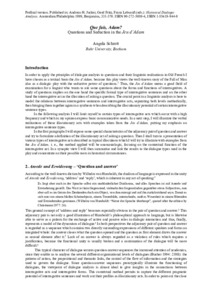| dc.date.accessioned | 2021-05-31T08:34:41Z | |
| dc.date.available | 2021-05-31T08:34:41Z | |
| dc.date.issued | 1999 | |
| dc.identifier | doi:10.17170/kobra-202104273753 | |
| dc.identifier.uri | http://hdl.handle.net/123456789/12872 | |
| dc.language.iso | eng | eng |
| dc.publisher | Benjamins | |
| dc.rights | Urheberrechtlich geschützt | |
| dc.rights.uri | https://rightsstatements.org/page/InC/1.0/ | |
| dc.subject.ddc | 440 | |
| dc.title | Que fais, Adam? | fre |
| dc.type | Teil eines Buches | |
| dcterms.abstract | In order to apply the principles of dialogue analysis to questions and their linguistic realisations in Old French I have chosen as a textual basis the “Jeu d’Adam”, because this play views the well-known story of the Fall of Man also as a dialogic play with the seductive power of questions. Thus, the “Jeu d’Adam” seems a good field of examination for a linguist who wants to ask some questions about the forms and functions of interrogatives. A study of questions implies on the one hand the specific formal type of interrogative sentences and on the other hand, the interrogative act as the illocution of asking a question. The crucial point in a linguistic analysis is here to model the relations between interrogative sentences and interrogative acts, separating both levels methodically, then bringing them together again in a synthesis when describing the illocutionary potential of certain interrogative sentence types.
In the following analysis, I will limit myself to certain types of interrogative acts which occur with a high frequency and which in my opinion express basic communicative needs. In a next step, I will illustrate the verbal realisations of these illocutionary acts with examples taken from the “Jeu d’Adam”, putting my emphasis on interrogative sentence types. In the first paragraphs, I will expose some special characteristics of the adjacency pair of question and answer and try to formulate a definition of the illocutionary act of asking a question. Then I shall turn to a presentation of various types of interrogative acts described as typical illocutions, which I will try to illustrate with examples from the “Jeu d’Adam”, i. e., the method applied will be onomasiologic, focusing on the contextual function of the interrogative act. In a synoptic view, I will then summarise and link the results to the dialogue types used in the play and concentrate on their possible roots in historical circumstances. | eng |
| dcterms.accessRights | open access | |
| dcterms.creator | Schrott, Angela | |
| dc.publisher.place | Amsterdam | |
| dc.publisher.place | Philadelphia | |
| dc.subject.swd | Onomasiologie | ger |
| dc.subject.swd | Interrogativsatz | ger |
| dc.subject.swd | Illokutiver Akt | ger |
| dc.subject.swd | Französisch | ger |
| dc.subject.swd | Historische Pragmatik | ger |
| dc.title.subtitle | Questions and Seduction in the Jeu d’Adam | eng |
| dc.type.version | acceptedVersion | |
| dcterms.source.collection | Historical dialogue analysis | eng |
| dcterms.source.editor | Jucker, Andreas H. | |
| dcterms.source.editor | Fritz, Gerd | |
| dcterms.source.editor | Lebsanft, Franz | |
| dcterms.source.identifier | isbn:1-55619-944-9 | |
| dcterms.source.identifier | isbn:90-272-5080-4 | |
| dcterms.source.pageinfo | 331-370 | |
| dcterms.source.series | Pragmatics & beyond ;; 66 | ger |
| kup.iskup | false | |

